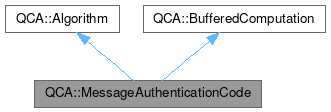QCA::MessageAuthenticationCode
#include <QtCrypto>

Public Member Functions | |
| MessageAuthenticationCode (const MessageAuthenticationCode &from) | |
| MessageAuthenticationCode (const QString &type, const SymmetricKey &key, const QString &provider=QString()) | |
| void | clear () override |
| MemoryRegion | final () override |
| KeyLength | keyLength () const |
| MessageAuthenticationCode & | operator= (const MessageAuthenticationCode &from) |
| void | setup (const SymmetricKey &key) |
| QString | type () const |
| void | update (const MemoryRegion &array) override |
| bool | validKeyLength (int n) const |
 Public Member Functions inherited from QCA::Algorithm Public Member Functions inherited from QCA::Algorithm | |
| Algorithm (const Algorithm &from) | |
| void | change (const QString &type, const QString &provider) |
| void | change (Provider::Context *c) |
| Provider::Context * | context () |
| const Provider::Context * | context () const |
| Algorithm & | operator= (const Algorithm &from) |
| Provider * | provider () const |
| Provider::Context * | takeContext () |
| QString | type () const |
 Public Member Functions inherited from QCA::BufferedComputation Public Member Functions inherited from QCA::BufferedComputation | |
| MemoryRegion | process (const MemoryRegion &a) |
Static Public Member Functions | |
| static QStringList | supportedTypes (const QString &provider=QString()) |
Additional Inherited Members | |
 Protected Member Functions inherited from QCA::Algorithm Protected Member Functions inherited from QCA::Algorithm | |
| Algorithm () | |
| Algorithm (const QString &type, const QString &provider) | |
Detailed Description
General class for message authentication code (MAC) algorithms.
MessageAuthenticationCode is a class for accessing the various message authentication code algorithms within QCA. HMAC using SHA1 ("hmac(sha1)") or HMAC using SHA256 ("hmac(sha256)") is recommended for new applications.
Note that if your application is potentially susceptable to "replay attacks" where the message is sent more than once, you should include a counter in the message that is covered by the MAC, and check that the counter is always incremented every time you receive a message and MAC.
For more information on HMAC, see H. Krawczyk et al. RFC2104 "HMAC: Keyed-Hashing for Message Authentication"
- Examples
- aes-cmac.cpp, and mactest.cpp.
Definition at line 827 of file qca_basic.h.
Constructor & Destructor Documentation
◆ MessageAuthenticationCode() [1/2]
| QCA::MessageAuthenticationCode::MessageAuthenticationCode | ( | const QString & | type, |
| const SymmetricKey & | key, | ||
| const QString & | provider = QString() ) |
Standard constructor.
- Parameters
-
type the name of the MAC (and algorithm, if applicable) to use key the shared key provider the provider to use, if a particular provider is required
◆ MessageAuthenticationCode() [2/2]
| QCA::MessageAuthenticationCode::MessageAuthenticationCode | ( | const MessageAuthenticationCode & | from | ) |
Standard copy constructor.
Copies the state (including key) from one MessageAuthenticationCode to another
- Parameters
-
from the MessageAuthenticationCode to copy state from
Member Function Documentation
◆ clear()
|
overridevirtual |
Reset a MessageAuthenticationCode, dumping all previous parts of the message.
This method clears (or resets) the algorithm, effectively undoing any previous update() calls. You should use this call if you are re-using a MessageAuthenticationCode sub-class object to calculate additional MACs. Note that if the key doesn't need to be changed, you don't need to call setup() again, since the key can just be reused.
Implements QCA::BufferedComputation.
- Examples
- aes-cmac.cpp.
◆ final()
|
overridevirtual |
Finalises input and returns the MAC result.
After calling update() with the required data, the hash results are finalised and produced.
Note that it is not possible to add further data (with update()) after calling final(). If you want to reuse the MessageAuthenticationCode object, you should call clear() and start to update() again.
Implements QCA::BufferedComputation.
- Examples
- mactest.cpp.
◆ keyLength()
| KeyLength QCA::MessageAuthenticationCode::keyLength | ( | ) | const |
Return acceptable key lengths.
◆ operator=()
| MessageAuthenticationCode & QCA::MessageAuthenticationCode::operator= | ( | const MessageAuthenticationCode & | from | ) |
Assignment operator.
Copies the state (including key) from one MessageAuthenticationCode to another
- Parameters
-
from the MessageAuthenticationCode to assign from.
◆ setup()
| void QCA::MessageAuthenticationCode::setup | ( | const SymmetricKey & | key | ) |
Initialise the MAC algorithm.
- Parameters
-
key the key to use for the algorithm
- Examples
- aes-cmac.cpp, and mactest.cpp.
◆ supportedTypes()
|
static |
Returns a list of all of the message authentication code types available.
- Parameters
-
provider the name of the provider to get a list from, if one provider is required. If not specified, available message authentication codes types from all providers will be returned.
◆ type()
| QString QCA::MessageAuthenticationCode::type | ( | ) | const |
Return the MAC type.
◆ update()
|
overridevirtual |
Update the MAC, adding more of the message contents to the digest.
The whole message needs to be added using this method before you call final().
- Parameters
-
array the message contents
Implements QCA::BufferedComputation.
- Examples
- mactest.cpp.
◆ validKeyLength()
| bool QCA::MessageAuthenticationCode::validKeyLength | ( | int | n | ) | const |
Test if a key length is valid for the MAC algorithm.
- Parameters
-
n the key length in bytes
- Returns
- true if the key would be valid for the current algorithm
The documentation for this class was generated from the following file:
Documentation copyright © 1996-2025 The KDE developers.
Generated on Fri May 2 2025 12:01:48 by doxygen 1.13.2 written by Dimitri van Heesch, © 1997-2006
KDE's Doxygen guidelines are available online.